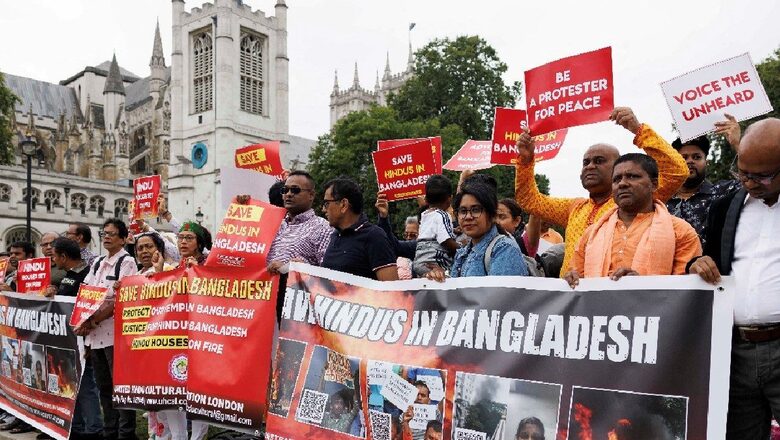
views
After ex-Prime Minister Sheikh Hasina resigned and fled from Bangladesh on August 5, 2024, there has been specific targeting of Hindus in Bangladesh, which includes widespread looting of Hindu houses and shops, vandalism of temples, lynching and killings of Hindu men, and abductions and rapes of Hindu women. X (formerly Twitter) is replete with videos showing Hindu homes in villages being burned down and their livestock killed. There have also been reports of hospitals, including government facilities, refusing treatment to Hindu patients. These incidents of Islamic atrocities against Bangladeshi Hindus and other minorities have drawn international condemnation, asking for the attacks to stop.
While the global community is expressing shock at the recent events in Bangladesh, such acts of barbarism are not new to the country.
The communal riots during the 1947 Partition and the 1971 atrocities committed by the Pakistan Army and Razakar-Ansar Bahini against Hindus should have been documented in world history under a chapter titled ‘Hindu Genocide.’ Unfortunately, discussions on these atrocities and the ongoing genocide of Hindus in Pakistan and Bangladesh remain a taboo subject among Western academicians. However, it is heartening to see that many Hindus are now awakening from their deep slumber and demanding the establishment of a ‘Hindu Genocide Day,’ similar to Holocaust Day for the Jews.
Below are brief details of some of the brutal massacres perpetrated by Islamists, the Pakistan Army, and their allies—the Ansar Bahini and the Razakars—on Bangladeshi Hindus after Partition and during the 1971 Indo-Pakistan war. The Razakars were an East Pakistani paramilitary force formed by the Pakistan Army during the 1971 war, and the Ansar Bahini, like the Razakars, were allies of the Pakistani Army.
Ramna Kali Temple massacre by the Pakistan Army – March 27, 1971
The Ramna Kali Temple massacre during the 1971 Indo-Pakistan war is either not well-known or has been forgotten by many. This massacre in Dhaka involved the killing of Hindus living in the area around the Ramna Kali Temple on the night of 26-27 March 1971.
According to Dr John Rohde of USAID, the Pakistan Army doused the 14th-century temple with petrol and set it on fire. Approximately 250 Hindus, including the temple priest, were killed, and the temple was destroyed. Rohde documented seeing burnt bodies of men, women, and children who had been shot dead (with machine guns) before being set on fire.
Interestingly, after the war, the Bangladesh government under Sheikh Mujibur Rahman chose not to rebuild the temple but instead confiscated the destroyed Ramna Kali Bari and its land. The temple land, located within the Dhaka Race Course, was handed over to the PWD, which then transferred it to the Dhaka Club.
A new temple was recently built (in 2021) with the help of the current Indian government. It stands beside the former Dhaka Race Course, which is now ironically known as Suhrawardy Udyan. Suhrawardy was infamous as the ‘Butcher of Bengal,’ under whose supervision the Direct Action Day occurred.
Anderson Bridge massacre – February 12, 1950
Anderson Bridge, also known as Bhairab Bridge, is a 1 km long railway bridge over the Meghna River in Bangladesh, connecting Bhairab Bazar Junction with Ashuganj. On February 12, 1950, most of the Hindu passengers travelling on this train route were murdered. The attackers boarded the train from both ends, at Bhairab Bazar Junction and Ashuganj. Once inside, they locked the doors of the compartments. When the train was completely on the bridge, it was brought to a halt. The assailants then selected Hindus one by one, forced them out of their compartments, slit their throats, and threw their bodies into the river.
According to reports from The Economist and The Manchester Guardian, trains from Ashuganj were stopped on Bhairab Bridge over the Meghna. The Muslim mobs then attacked the Hindu passengers from both sides of the bridge. Those who attempted to dive into the river and swim to safety were struck with bricks and drowned. Eyewitness Pierre Dillani reported that approximately 2,000 Hindus were massacred on the Bhairab Bridge.
Chuknagar Massacre
While the Chuknagar massacre is among the deadliest attacks on Hindus during the 1971 war, it remains poorly documented and largely unknown.
Chuknagar is a small town in Dumuria, Khulna, near the Indian border. When the Pakistani Army launched the brutal Operation Searchlight, many Hindus fled from Khulna and Bagerhat and took refuge in Chuknagar, hoping to cross into India via the Satkhira Road. By May 15, 1971, as the Pakistani Army intensified its killings, more fleeing Hindus gathered in Chuknagar. On May 20, the army, in 2-3 trucks equipped with semi-automatic rifles and light machine guns, arrived at Pathkhola ground (Jhautala) near Chuknagar Bazaar. They opened fire and then moved to Chuknagar Bazaar, continuing the assault until 3 pm. After the killings, the Pakistani Army reportedly looted the belongings of the dead Hindus.
It is estimated that about 10,000 people, mostly Hindus, including children, were killed in the firing by Pakistani forces. Bangladeshi writer Shahriar Kabir stated, “Within 5 hours, 10 to 12 thousand innocent people, who were resting there before fleeing to India, were killed.” Professor Muntassir Mamoon, in his book 1971 Chuknagar Genocide, describes the massacre in detail: “At around 10 am, two trucks carrying Pakistani troops arrived at Kautala, then known as Patkhola…As soon as the trucks stopped, the Pakistani troops alighted, carrying light machine guns and semi-automatic rifles, and opened fire on the public. Within a few minutes, a lively town turned into a city of death.”
The Dhaka Tribune reported at the time that the area was filled with bodies, and the Bhadra River had turned red with the blood of the fallen victims.
Unimaginable Brutalities from the 1971 Hindu Genocide in Bangladesh, as Narrated by Arunudoy Bhattacharjee
India-Bangladesh border areas were the sites where Hindus were killed the most by the Ansar Bahini members.
- Lifeless Trains: When trains carrying Hindu refugees approached Karimganj, India, they would be stopped at the Bangladesh border. Members of the Ansar Bahini would then board these trains, moving from compartment to compartment, slaughtering men and abducting and raping women. Women who resisted were also killed. Many of these trains, filled with the bodies of Hindus, would then cross into Indian territory.
- Rivers Red with Hindu Blood: Trains heading towards India would be halted on bridges in Bangladesh. Mass slaughters and rapes would commence. With no escape, many Hindus would jump into the crocodile-infested waters below. It is said that the River Bhairab turned red with the blood of Hindus during these events.
- The Bus in the Middle: In one incident, three buses carrying refugees were approaching the Indian border. A bomb exploded in the middle bus, instantly killing all the Hindus aboard.
- No Escape: Hindu women, bearing visible signs of trauma and abuse, would be seen wandering the streets of Sylhet town. Many had children with them. Some made a desperate attempt to cross the border into India, only to be stopped by Ansar Bahini members, who would continue their assault and killings. These Hindu women could not escape the barbaric Muslim Bahinis.
Islamic brutality against non-Muslims or “kafirs” is not new and has been ongoing since the birth of Islam. Hindus, in particular, have suffered greatly from these brutalities, starting from the medieval era when Islam arrived in the Indian subcontinent, leading to widespread killings, rapes, and forced conversions. Unfortunately, even in the 21st century, the persecution of Hindus by Muslims continues. What was initiated by a group of fanatical foreign invaders is now being perpetuated by Indians who converted to Islam under severe persecution.
The author is a well-known travel and heritage writer. The views expressed in the above piece are personal and solely those of the author. They do not necessarily reflect News18’s views.

















Comments
0 comment